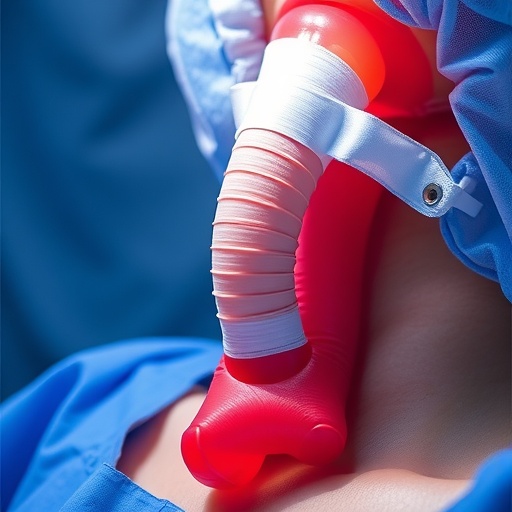
In the rapidly evolving field of thoracic surgery, the question of whether to routinely wrap tracheobronchial anastomoses following resection and reconstruction has long been a subject of debate among surgeons. A pioneering study led by Professor Shuben Li at the First Affiliated Hospital of Guangzhou Medical University, featured in the April 2025 issue of Translational Lung Cancer Research, brings renewed focus to this clinical controversy. The investigation delves deeply into the effectiveness of wrapping the anastomotic site with autologous tissue and its impact on postoperative outcomes, offering robust data and fresh insights that could reshape surgical protocols in airway reconstruction.
Tracheobronchial resection and reconstruction, despite technological and procedural advances, remain some of the most technically demanding interventions in thoracic surgery. The risks are notably high, with morbidity and mortality tied closely to the integrity and healing of the anastomotic junction. Historically, the decision to wrap the anastomotic site with vascularized autologous tissues—such as pedicled muscle flaps, pleura, or even omentum—has been predicated on the hypothesis that providing additional biological support fosters enhanced healing, reduces tension, and shields the vulnerable suture line from surrounding inflammation and infection. Nevertheless, definitive evidence substantiating these benefits had remained elusive until this latest observational study offered substantial empirical evaluation.
The study cohort consisted of 95 patients, with a fairly balanced gender distribution (31.6% female), undergoing tracheobronchial resection and reconstruction. These were stratified into two main groups: those undergoing complex surgeries, characterized by procedures such as extended resections and reconstructions involving more than 4 centimeters of airway, and those receiving standard surgeries with less extensive interventions. Within each group, patients were further subdivided based on whether their anastomoses were wrapped with autologous tissue or left unwrapped, allowing for a rigorous comparative analysis.
.adsslot_O02g359yGB{width:728px !important;height:90px !important;}
@media(max-width:1199px){ .adsslot_O02g359yGB{width:468px !important;height:60px !important;}
}
@media(max-width:767px){ .adsslot_O02g359yGB{width:320px !important;height:50px !important;}
}
ADVERTISEMENT
Complex airway surgeries present unique challenges due to the increased length of resected airway segments and the complications associated with neoadjuvant therapies, which tend to impair tissue healing and vascular integrity. It is within this subgroup that the potential advantage of wrapping the anastomosis may be most pronounced. The investigators observed a statistically significant reduction in short-term anastomotic complications among patients receiving wrapped reconstructions in the complex surgery group, with a p-value of 0.004 attesting to the robustness of this finding. This included decreases in complications such as anastomotic dehiscence, stenosis, and fistula formation within the critical early postoperative period.
Interestingly, the study noted that long-term complication rates did not differ significantly between wrapped and non-wrapped subgroups, suggesting that while wrapping may confer early postoperative advantages, its influence on delayed adverse events may be limited. This temporal facet underscores the complexity of anastomotic healing, which encompasses phases of inflammation, proliferation, and remodeling. The initial reinforcement provided by wrapping appears crucial in navigating the vulnerable early healing window, potentially interrupting a cascade of detrimental events that can culminate in anastomotic failure.
In contrast, among patients undergoing standard tracheobronchial surgeries—which typically involve shorter resections and less extensive tissue manipulation—no statistically significant differences were observed in postoperative complication rates between wrapped and non-wrapped anastomoses. This finding implies that routine wrapping in these simpler cases may be unnecessary and does not confer measurable clinical benefit. It also highlights the importance of tailoring surgical strategies to the complexity of the procedure and patient-specific risk factors, rather than adopting a one-size-fits-all approach.
The juxtaposition of these results invites a reevaluation of surgical dogma, particularly the prevailing notion that meticulous suturing technique and preservation of surrounding airway structures alone suffice to ensure anastomotic integrity. While technical precision remains indispensable, the adjunctive role of biological reinforcement via autologous tissues emerges as a key facilitator of optimal short-term healing in high-risk contexts. The vascularized tissue flaps employed for wrapping not only serve as mechanical buffers but also as reservoirs of angiogenic and reparative factors that promote tissue regeneration.
Professor Li’s team incorporated a diverse array of autologous tissues for wrapping, carefully selected based on vascular supply and proximity to the anastomotic site. Muscular flaps derived from pedicled muscles were favored in some cases for their robust blood supply, while pleural and glandular tissues were utilized depending on anatomical feasibility. The study underscores that the choice of wrapping material should be individualized, integrating considerations such as donor-site morbidity, surgical access, and the patient’s overall condition.
Moreover, the observational study design allowed the researchers to capture data representative of real-world clinical outcomes across various patient profiles, lending external validity to their conclusions. However, the authors acknowledge that randomized controlled trials are warranted to definitively establish causal relationships and refine evidence-based guidelines for the routine application of wrapping in tracheobronchial reconstructions.
The clinical significance of these findings extends beyond the immediate sphere of airway surgery. As complex resections become increasingly common—propelled by advances in oncological therapies and growing expertise in thoracic surgical oncology—peri-anastomotic management strategies assume heightened importance. Optimizing early healing not only improves patient outcomes by diminishing postoperative morbidity but may also reduce hospital stays and associated healthcare costs, addressing broader systemic concerns.
Notably, this study encourages ongoing innovation in surgical technique, suggesting a paradigm shift toward integrating biological adjuncts with precision mechanical approaches. Future research avenues may explore bioengineered scaffolds, growth factor delivery systems, or tissue engineering constructs as supplementary or alternative wrapping materials, aiming to enhance healing while minimizing donor-site complications.
This comprehensive assessment, stemming from a single-center experience yet illuminating a critical clinical question, reinforces the nuanced balance between surgical art and science. While the decision to wrap the tracheobronchial anastomosis has been historically individualized and often based on surgeon preference, emerging evidence now supports a more systematic application of wrapping in patients undergoing complex resections to mitigate early postoperative complications effectively.
In sum, Professor Shuben Li and colleagues have contributed a pivotal piece to the evolving puzzle of airway reconstruction surgery. Their findings clarify that while wrapping the anastomotic site may not universally benefit all patients, it serves as a valuable adjunct in complex tracheobronchial surgeries, enhancing short-term outcomes and potentially paving the way for improved long-term patient care.
Subject of Research: People
Article Title: Tracheobronchial resection and reconstruction: to wrap or not to wrap the anastomosis?
News Publication Date: 30-Apr-2025
Web References: http://dx.doi.org/10.21037/tlcr-24-868
Keywords: Lung cancer, Clinical studies
Tags: airway surgery advancementsanastomotic site healingautologous tissue in surgeryinnovative surgical protocols in thoracic medicinemorbidity and mortality in airway surgerypostoperative outcomes in thoracic surgeryProfessor Shuben Li researchresection and reconstruction challengesthoracic surgery clinical practicestracheobronchial anastomoses techniquesvascularized autologous tissues in surgerywrapping techniques for anastomoses



